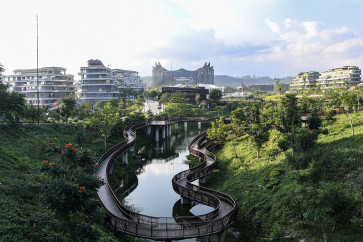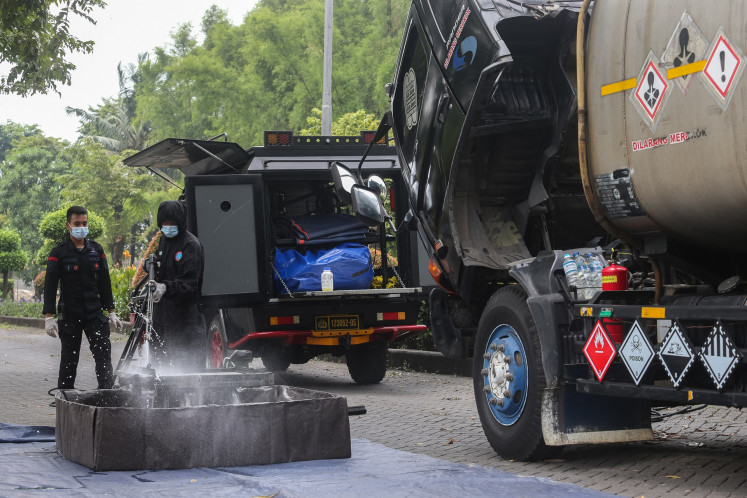Popular Reads
Top Results
Can't find what you're looking for?
View all search resultsPopular Reads
Top Results
Can't find what you're looking for?
View all search resultsDutch cemetery rich with Jakarta history
Just inside the gates, visitors are greeted by romantic angels, Gothic turrets, sleeping children, marble crosses and heavy tombstones with baroque coats-of-arms, bringing to mind ancient cemeteries in Europe
Change text size
Gift Premium Articles
to Anyone
Just inside the gates, visitors are greeted by romantic angels, Gothic turrets, sleeping children, marble crosses and heavy tombstones with baroque coats-of-arms, bringing to mind ancient cemeteries in Europe.
But don't expect to find lines of votive candles to remind us the dead still have living relatives who care.
This is an old Dutch cemetery located on Jl. Tanah Abang I in Central Jakarta.
The cemetery was officially opened Sept. 28, 1797, but people were first buried here as early as 1795.
On entering the cemetery, through a Parthenon-like portico (built in 1844), visitors get a rare glimpse of a bygone section of Jakarta's historic populace -- albeit in a neglected state.
Inside the portico is a bronze death knell with an atmosphere of mourning in times gone by.
Bodies of prominent figures were once buried here, including Maj. Gen. J.H.R. Kohler, the Dutch general who tried to conquer Aceh; archeologist W.F. Stutterheim, who wrote a famous book on the Hindu hero Rama; the founder of the famous STOVIA medical school, F.H. Roll; and J.L.A. Brandes, a famous archeologist who actively collected Hindu statues (a collection now in possession of the National Museum of Indonesia).
The tombstone of Olivia Marrianne Raffles (1814), the first wife of British Gov. Gen. Sir Thomas Stamford Bingley Raffles, stands in the grounds of Museum Taman Prastasi. (JP/Matheos Viktor Messakh)
The headstones of several non-Dutch people can also be found here, such as Olivia Marrianne Raffles (the first wife of British Governor General Sir Thomas Stamford Raffles), activist Soe Hok Gie and the famous 1930s artist Miss Riboet.
People from various corners of the globe, including Southeast Asia, Saudi Arabia, India and China have been laid to rest here.
Many stones in the cemetery date from long before it was officially built. These stones were brought to the cemetery when several churches in Batavia were demolished at the beginning of the 19th century. Some of these were inserted into the cemetery wall, while others were placed within the yard.
After Indonesia's declaration of independence, the park was used as a Christian cemetery. Within the first two years it was managed by the Verberg Foundation and for the next twenty years it was handled by the Palang Hitam Foundation.
From 1967 to 1975 the cemetery was managed by the Jakarta burials agency, and then it was closed for burials to make way for the construction of the Central Jakarta mayoralty office.
At a request from the local government, some corpses were removed by relatives while others were taken to Tanah Kusir cemetery in South Jakarta.
One of the remaining statues that stands in the old Dutch cemetery now known as Museum Taman Prastasi (the Museum of Memorial Stone Park), in Central Jakarta. (JP/J. Adiguna)
Many tombstones, sculptures and statutes were removed and damaged during the construction of the office and now only 32 tombstones remain in their original positions.
The size of the cemetery, originally on a 5.9 hectare plot was also reduced to 1.3 hectares.
Jakarta History Museum head M.R. Manik said only about 1,200 of 4,200 stones were selected to be kept in the cemetery, which was officially opened as the open-air Museum Taman Prasasti or Museum Park of Memorial Stones.
"The tombstones were selected due to their unique designs that represent a period in history, the role of the deceased in history, or because they were too heavy to be removed," said Manik, who became head of the inscription museum from 1988 to 1998.
In July 1994, three landscape architecture students from Trisakti University won a design contest for the development of the open-air museum.
However, the execution of the design, undertaken by a private contractor, was only loosely based on the design, which won the Merit Award at the Congress of the International Federation of Landscape Architects in Bangkok in October 1995.
"If the stones were grouped into specific periods, one could see the history of Jakarta just by wandering through the park," said Nirwono Joga, one of the students who is now a landscape architect.
Many tombstones in the park have rich stories, such as the story of the mysterious tomb of Captain Jass; or the story of Pieter Erberveld, a German native and captain of the Batavian cavalry who was tortured to death with his followers on April 22, 1722, on an accusation of treason.
The material and style of tombstones, with unique characters and stories behind each, Nirwono said, could become resources for cultural and architecture studies and even had potential to become one of the best centers for cemetery studies in Asia.
"Much work could be done if people were only aware of how valuable this cemetery is as a historical asset. We could market the historical importance of this site," said Nirwono, who has identified 1,323 artifacts at the site.
"It's dangerous if a museum is not managed as part of people's lives. Nobody would care if they get demolished for new modern projects," he said.
Nirwono conducted a 10-year research project on the cemetery, which resulted in a book titled 'Museum Taman Prasati: Metamorfosis Kerkhof Laan Menjadi Museum' (Museum Park of Memorial Stones: The Metamorphosis from Kerkhof Laan to Museum).
The cemetery may be the oldest modern cemetery in the world, he said.
Nirwono has compared the Tanah Abang museum to Fort Canning Park (1926) in Singapore; Gore Hill Cemetery (1868) in Sydney; La Chaise Cemetery (1803) in Paris; and Mount Auburn Cemetery (1831) in Cambridge; Massachusetts.
"Based on data on the official opening dates of those cemeteries, the Tanah Abang cemetery is the oldest.
"But it is unlikely to nominate this historic area to UNESCO as a World Heritage site because only 32 of its 1,000 tombstones are standing in their original positions, and also the park doesn't function as public cemetery anymore," Nirwono said.
The museum is also home to the coffins of Indonesia's founding president, Soekarno, and vice, Mohammad Hatta, and a replica of a 17th-century hearse.
Why this cemetery has become so neglected remains a sad mystery, reflected in an inscription on Soe Hok Gie's tombstone: "Nobody knows the trouble I see, nobody knows my sorrow".











